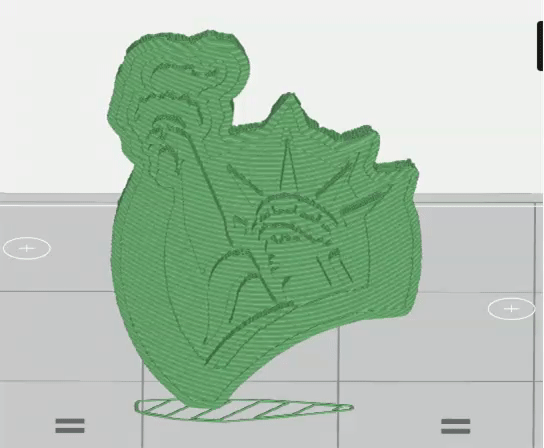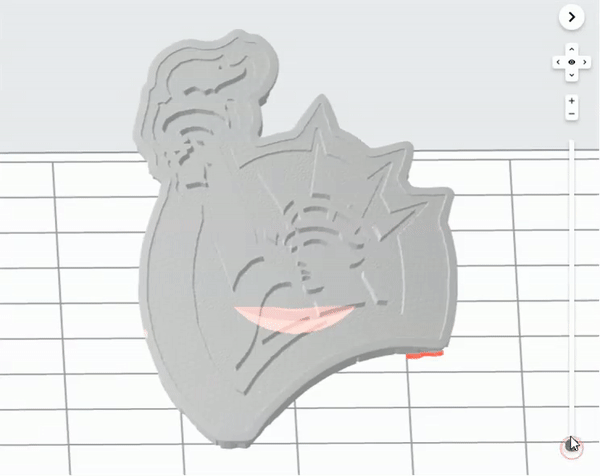Hollywood 3D Printing Blog
3D Printing in Resin vs. ABS Plastic: Surface Detail Explained
Do you want to create 3D Printed parts with crisp, high-resolution detail? Learn the difference between the two most common 3D Printing materials, and why not all 3D Printed parts are created equal.

Comparison of a small 1" tall part in SLA Resin (left) and ABS Plastic (right)
As you can see, not all 3D Printed parts are created equal.
When it comes to 3D Printing, it's important to choose the right type of material and printing process that will lead to the best outcome according to your goals for each individual part. Do you want to 3D Print a strong part with maximum durability? Or, are you
more focused on getting something smooth and highly-detailed, where durability isn't as important?
If you're prototyping a new product design made of multiple pieces, you're probably more focused on getting parts that can be handled and assembled without having to worry about breakages. If you're creating something ornamental -- a display piece, jewelry, or a sculpture -- then your top priority
is likely going to be getting high-resolution surface detail.
There are many material options out there, each with its own pros and cons, so the material option you choose for a product prototype is likely going to be different from the material you choose for an ornamental item.
This article focuses on the visual differences between two of the most common 3D Printing materials: SLA Resin and ABS Plastic.
Before we get into these materials, let's cover the basic concept behind 3D Printing to help us understand why different material options have different appearances.
The 3D Printing Process
The main concept behind 3D Printing is that a part is built up in layers, one thin sliver at a time. The job of a 3D Printer is to repeatedly create each cross-sectional layer of a part as precisely as possible, in a uniform and consistent fashion.

Visualization of a three-dimensional part as a stackup of individual two-dimensional layers.
The first layer of a 3D Printed part is deposited onto a flat platform area. This flat platform is attached to a mechanism which can move the platform up and down in very small increments. Each time one layer of the part is created, the build platform will move down by a very small amount, to make room for the next layer of material to be built on top of the previous layer.
It is this repetitive sequence of "new layer of material, platform moves down, new layer of material, platform moves down..." which allows us to create three-dimensional objects.
The key to producing a part with a high level of smoothness and detail is to make these individual layers as thin as possible. The thinner the layers on a 3D Printed part, the smoother and more uniform the surface of that part is going to be.
While all 3D Printers operate on this layer-by-layer process, the machine process for producing SLA Resin parts is not the same as the machine process for producing ABS Plastic parts. This is why two parts built from the same original 3D Model design, but in different materials, are not going to look identical.
Why 3D Printed Resin Parts Are So Detailed
A 3D Printer which produces parts in resin does so by using a very focused ultraviolet laser light to harden a liquid resin into a solid plastic form, layer by layer. The liquid resin is photosensitive, and hardens when exposed to ultraviolet light. This process is called Stereolithography.
Since the laser beam used to cure the resin from a liquid into a solid can be focused into such a precise pattern, the thickness of the layers which make up a 3D Printed resin part can be very thin, with highly accurate horizontal shape variations across each layer.

Animation of the invidivual layer-building for a part 3D Printed in SLA Resin
The layers created in the Stereolithography 3D Printing process are so thin that it's often difficult to see them without magnification.
So, what about 3D Printing in ABS Plastic? Why does this other process produce parts with lower surface detail?
Comparison with 3D Printing in ABS Plastic
The process behind building parts in ABS Plastic is called FDM, for Fused Deposition Modeling.
In the FDM 3D Printing process, layers of material are deposited in a melted plastic strand, one on top of another. Each new strand of material instantly cools from semi-liquid to solid, and fuses to the layer below it.
Similar to a hot glue gun, an FDM 3D Printer takes a solid material filament and heats it up while pushing it through a small extrusion nozzle. The material comes out the other end of the extrusion nozzle in a thin semi-liquid strand, which immediately cools into hard plastic when exposed to air.

The build lines lines on an FDM-built part are visible to the naked eye, as seen in this digital pre-visualization rendering.
While the extruded material strand on an FDM printer is quite thin, it doesn't compare with the laser-thin precision of the SLA Resin process.
These linear striations created by the layer stacking on a 3D Printed part -- also known as build lines -- are considerably thicker for FDM-built parts than for SLA-built parts.
SLA vs FDM: Build Line Thickness
So, how thick are the build lines in each of these 3D Printing processes?
For SLA Resin parts, build lines have a thickness of 50 microns, or 0.05mm. For ABS Plastic parts built using an FDM process, the build line thickness is 250 microns, or 0.25mm.
Given that SLA Resin parts have 5X the layer resolution of ABS Plastic parts, the clear winner for 3D Printing parts with crisp, high-resolution detail is SLA Resin.
Get Inspired
Browse through hundreds of examples of our 3D printing, 3D design, and custom fabricated builds.